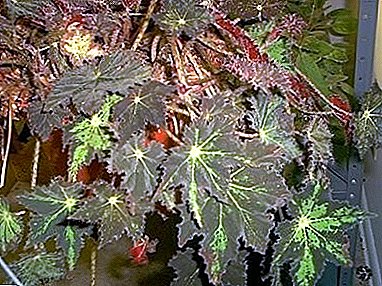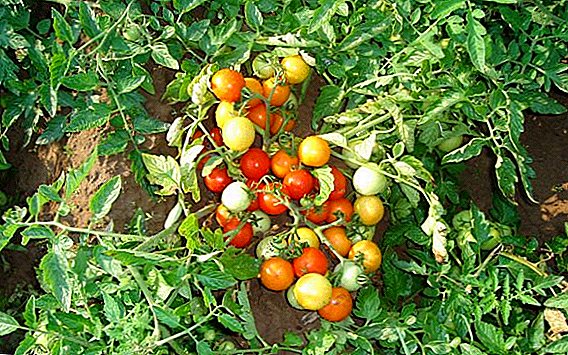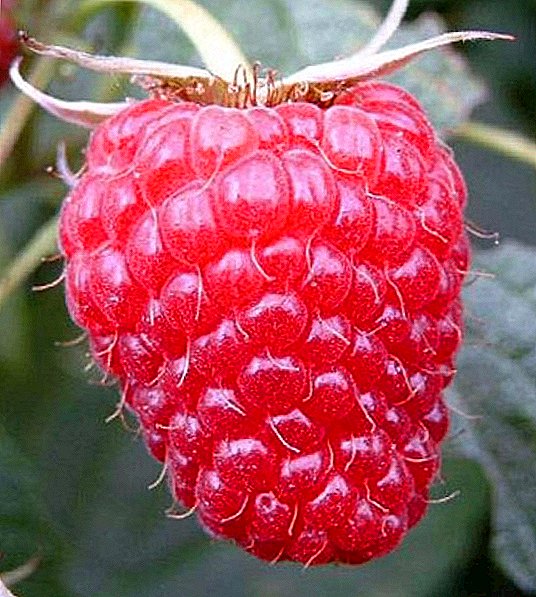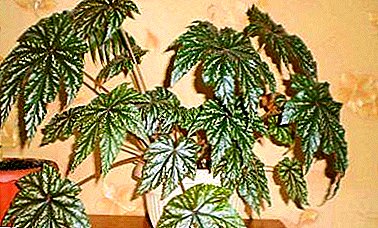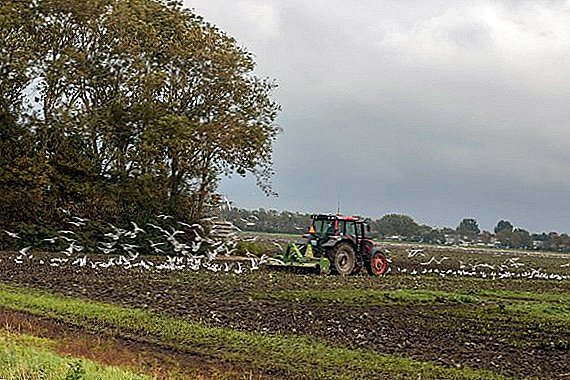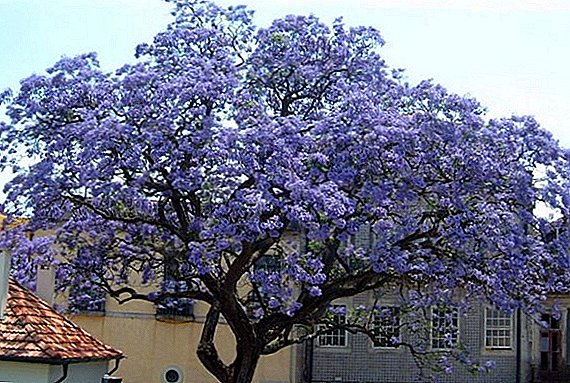 Paulownia is an exotic tree for a temperate climate.
Paulownia is an exotic tree for a temperate climate.
It is rarely found in the parks of these latitudes, however, it is common in the Far East.
Let's find out whether it can grow on your site and how to do it.
Description and photo
Paulownia or Adam's tree is a deciduous plant from the Pavlovniy family. It is mainly grown in Japan, Korea, Vietnam and China. It can also be found in the south of Russia, Ukraine, Europe, North America and the Caucasus.  A fast-growing plant, the average height is from 9 to 15 m, and some species can reach 22 m in height.
A fast-growing plant, the average height is from 9 to 15 m, and some species can reach 22 m in height.
The crown grows to 6 m. The trunk diameter is -110-115 cm. Paulownia has large deltoid leaves, 25 cm wide and 30 cm long. The flowers of the tree bloom in spring before the leaves appear. They are pale purple with a yellow center.
The flowers have a bell-shaped form and grow 20-30 cm in length. The fruit is an egg-shaped box with a large number of winged seeds.
Adam's tree lives up to 100 years. Paulownia is used to make furniture, musical instruments and other items made of wood. Its advantage is soft wood.
Did you know? In Japan, there used to be a custom: if a girl was born, then her parents would plant paulownia. When an adult girl was already married, a pouch made of paulownia wood into which all the dowry was placed was made.Also, certain species are cultivated as an ornamental plant and planted in parks and squares.

Popular species
There are from 5 to 7 species of adam tree. Let's look at the description of the most popular types of paulownia tree with photos.
Paulownia felt or Imperial tree. The habitat of the species covers China, Europe and North America.
You can also decorate your plot with trees such as red maple, ash, acacia, larch, white willow, birch, catalpa, chestnut, elm, hornbeam, Japanese maple, pyramidal poplar, pine.The plant has a sprawling ovoid crown, pale purple (sometimes white) flowers and large leaves. Flowers bloom more often before the appearance of the leaves, at least - during. The leaves fall in late autumn.
This type can reach 20 m in height. The plant does not tolerate winter temperatures below -20 ° C, so it is not suitable for cultivation in the northern regions. Grown as a landscape tree, because large leaves give a good shade. 
Paulownia Farghez. Cultivated in the mountainous provinces of China and Vietnam. This species grows up to 20 m. It is distinguished by its white flowers. Leaves 30-35 cm long, 25 cm wide. Flowering begins in early spring. It tolerates drought.
Pavlovnia Farghezu can be confused with the Catalpa tree, because both plants have white flowers in the form of a bell and large leaves. But the catalpa flowers bloom in late May, when a dense crown of leaves has already been formed.
Also, catalpa fruit is a pod that can reach 50 cm. But both trees have a similar habitat. 
Paulownia oblong or Paulownia elongated. Habitat covers China. It grows up to 10 m in height. The leaves are egg-shaped, have pubescence on the underside. Paulownia oblong forms inflorescences of purple-pink color. 
Paulownia Forchuna. The species grows in the highlands of China, but is also known in Taiwan, Vietnam and North America. An adult tree can be 30 m tall. The leaves are large, as with any type of Pavlovniev family.
Did you know? A tree such as paulownia is not only high-quality wood, but a honey plant, which helps with respiratory disease. His honey is similar to acacia honey, has the same healing properties.Forchuna is distinguished by its trunk (2 m in diameter), as well as young shoots and inflorescences, which have yellowish pubescence. The flowers are light purple to 25 cm in length.

Growing conditions
Paulownia - a plant with a high degree of adaptability. In the wild, it grows in mountainous areas, but the optimum height above sea level for cultivation is 700-800 m. The main condition for cultivation is a warm, humid climate.
Lighting and location
Any of the above types of paulownia should occupy a sunny place. The optimum temperature in the spring-summer period is + 24-33 ° С. Paulownia can withstand wind up to 7-8 m / s, but no more.
Particularly susceptible to strong gusts of young trees, the trunk of which is not sufficiently stiff. Therefore, if possible, grow it in windless areas.
Paulownia is transplanted to a permanent place when the seedling is already 1 year old. 
Optimum soil
The plant is not fastidious to the soil. It will grow well on sandy, drained soils. Hydrogen indicator is allowed from pH 5 to pH 8.9. But the best will be around 6.5 pH.
Avoid heavy soils, for example, high clay content. In this case, the soil will not flow well and the tree will die.
Landing technology
Planting technology depends on the climate in which the plant will develop. In temperate latitudes, it is difficult to grow paulownia from seeds, since there may be no material.
After all, an Adam tree usually does not set fruit under uncomfortable temperature conditions. In such a case, grafting is an excellent option.  Growing paulownia from root offspring can also be difficult. Despite the rapid growth of the tree in height, the root system develops slowly.
Growing paulownia from root offspring can also be difficult. Despite the rapid growth of the tree in height, the root system develops slowly.
If you have a ready sapling, then it will be planted along with a land clod. The pit should be 3-4 cm in diameter more than the earth bed, so that there is room for backfilling the soil mixture.
And it is prepared from 1 part of sod land, 2 parts of peat and 2 parts of sand. After you have rammed the ground, you need to water the seedling plentifully. Note that when planting a seedling, the root neck should be at ground level.
From seed
If you decide to grow paulownia from seeds, then you cannot bury them in the ground when planting. Paulownia, like rhododendrons, is sown directly on the soil. You can do this in various ways. 
1 way: using a napkin.
To do this, you will need any plastic container with a small lid. At the bottom you need to put a regular napkin. Preferably loose. Then moisten with spray water.
From the seeds also grow laurel, acacia, strawberry tree, castor-bean, thuja, blue spruce, cobweb, fir, aziminu, fig tree, eucalyptus, coffee tree.Sprinkle a small amount of seeds and moisten them also with water. With the lid on the seed bowl, put it in the fridge for two days.
Upon expiration of the capacity must be moved to a sunny place and leave for 10 days. Air tank every 2-3 days. From 10 to 14 days the seeds begin to germinate. It is at this time you need to put them in a pot with nutrient soil.  After that, sprinkle the germinated seeds with a small amount of earth, but be careful, they cannot be completely covered with earth. Pour over water. The tree grows quickly, so this sowing of seeds is done in the fall, so that in the beginning of summer a small tree could be planted.
After that, sprinkle the germinated seeds with a small amount of earth, but be careful, they cannot be completely covered with earth. Pour over water. The tree grows quickly, so this sowing of seeds is done in the fall, so that in the beginning of summer a small tree could be planted.
Important! Seeds are moved on a napkin, in any case, do not try to "remove" them.2 way: germination immediately in the pot.
To do this you will need a small pot of nutrient soil. It must be poured to such a level that the water still remains in it for at least 10 days. That is, to make a kind of "swamp".
Then sift the seeds there and wait 10-14 days until the seeds sprout. But do not forget that you need to cover the pot with cling film and air the seeds every two days.  The advantage of this method, as well as the first, is that you do not need to monitor the seedlings. Enough to give the optimum amount of sunlight and moisture. But the second method includes one minus: with an excess amount of water that is not absorbed within 14 days, the seedlings will die.
The advantage of this method, as well as the first, is that you do not need to monitor the seedlings. Enough to give the optimum amount of sunlight and moisture. But the second method includes one minus: with an excess amount of water that is not absorbed within 14 days, the seedlings will die.
Important! Seeds need to be sown immediately after harvest or purchase, since after 6 months they lose their germination.
From cuttings
Cuttings are best taken from a young tree (which is 2-3 years old). They are buried in a loose, moist soil completely. Sometimes you can leave a small part of the cutting above the ground (2-4 cm).
When several shoots appear already more than 10 cm, the strongest and highest are left, while others are removed. Cutting recommended in early spring. 
From root offspring
Paulownia is rarely grown from root shoots because the plant has a weakly branched root system that slowly develops. Therefore, it is often not possible to get quality material.
However, the tree can produce additional shoots that are connected by the root system to the mother tree. In this case, you can dig out the shoot and separate it from the mother tree (cutting the roots with a shovel). Recommend to hold it in the fall or spring.
Adam care
Paulownia needs regular watering, despite its drought tolerance. Watering a young tree (1-3 years) should be done every 10 days with 10 liters of water. A more mature individual requires watering every two weeks to 15-20 liters.
But try not to flood the plant, otherwise it will weaken its immunity.  Adam's tree is not whimsical to fertilizers, but like many plants it responds to feeding chicken droppings or peat. They can be made in the fall and spring. Also, the plant is well tolerated vermicompost.
Adam's tree is not whimsical to fertilizers, but like many plants it responds to feeding chicken droppings or peat. They can be made in the fall and spring. Also, the plant is well tolerated vermicompost.
Trimming for the adomai tree is not obligatory, because its crown is branchy and because of this it is very beautiful. But paulownia also tolerates any kind of scrap.
Diseases and pests
Adam's tree is susceptible to fungal diseases and is not resistant to such pests as aphids and scab. To avoid fungal diseases, try not to overwet the soil, do not multiply paulownia on the ground where such diseases used to be.
Also, before planting, seedlings are recommended to pour biofungicides on the ground, which will prevent the appearance of fungus. After all, young trees have weak immunity.  Insecticides will help you to get rid of shitovki and aphids. They recommend paulownia to spray after winter to get rid of eggs and other pests.
Insecticides will help you to get rid of shitovki and aphids. They recommend paulownia to spray after winter to get rid of eggs and other pests.
Having learned what an Adam tree looks like, many gardeners want to plant it on their plot. And you can safely do this if you live in an area with a warm and humid climate. Remember that the correct landing site will determine how it blooms and multiplies.


